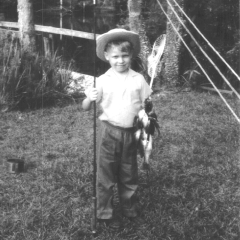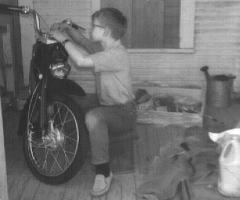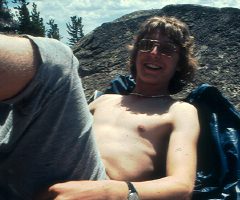





Personal Background of John
Born and raised in the piney woods of East Texas, in the small blue collar town of Center which had a hardwood flooring plant, a poultry plant, and seemingly countless chicken hatcheries. I grew up fishing for bass and perch (mostly at Toledo Bend). My father loved machines - motorcycles in particular. Art came from my mother’s side. Her father was an early photographer, when it was still a new craft, with enough wood working skills to make his own violin. Early I pursued drawing and by ten, I was asking my mom for summer art classes, where I practiced my favorite drawing genres: hot rod dragsters and cartoons.Building Bikes
When I was twelve, we moved into a house that was connected to a motorcycle shop my father built and owned. Since motorcycles came in crates unassembled, from age twelve on, I worked every day after school, on Saturdays, and in the summers assembling motorcycles - hundreds of motorcycles. As if that wasn’t enough, during off hours, I worked in the shop customizing my own motorcycles, making minibike choppers or altering engines to double their displacement. I had the opportunity to race motocross, ride trials bikes, and travel across ten states in repeated long distance trips on road bikes.As the end of high school approached, I decided I did not want to spend the rest of my life in a motorcycle shop, so to the disappointment of my father, I decided to go to college. I took what I thought was a big step and entered a local state college as an art major. I lost the hair and gained a seriousness about what life was for. In a time of much internal exploration, I decided that art alone did not satisfy my desire for concrete tangible accomplishment, so I decided on architecture.
College & travel
I still wonder how . . . but I was accepted at the University of Texas at Austin during my first year at a local college. I had gone from building motorcycles and my high school graduating class of 125 persons to a university of 42,000 students. Architecture school is a wonderfully intense experience with a tightly knit subculture. Going days without sleep to work on studio project deadlines was typical. I applied my full effort to architecture school and my aesthetics, or previous lack thereof, was transformed. Almost as influential was a summer long solo trek across Europe focused on architecture that I took during my 3rd year. Since then I have been hooked on travel as a means of architectural education and creative recharge - returning for several long travel trips as well as work abroad.Family
Before leaving school I became engaged to another architectural student and married shortly after. Thus began a time of marriage, children, and mortgage payments, but that is a different story.Career
The career fun started when I began my firm in 1988, eight years after college. It was only through the confidence and patronage a mentoring developer gave me that I was able to start a firm. During that time, I worked on hundreds of projects, won historic preservation awards including four years in a row, practiced abroad, was advisor to a college historic preservation program, and served six years as architect member for a local government HARB, however, I have greater satisfaction in the mentoring of 20+ architectural interns.The project types have been particularly diverse (it might seem like I can't settle on a profession) from furniture design to town planning. I will discuss three projects I am particularly grateful to have been entrusted with: the Stocking Works, Witchell Salon, and Shindagha - one architecture project, one interior project, and one urban design project. Each represents the opportune project in which I defined my approach and formmaking skills. These show who I am (professionally).
Conceptual
I have always favored dichotomous compositions over singular vocabulary solutions (maybe it has to do with me being a blue collar motorcyclist / white collar architect). Thus, in the Stocking Works, it even developed into a slogan (still working on the jingle) “Historic preservation through respectful contrast.” With this approach I could respect historic forms and employ modern new forms. It has defined most of my work, even non-historic projects. This approach is to set up contrasting form vocabularies as counterpoints to each other. Then, to place them in close proximity or intertwine them to create a composition of interest. The classic expression (for me that is) would be to use colorful, simple, sinuous modern forms inside a heavy historic context. It is most provocative when the contrasting forms employ an overlay of perceivable meanings, such as, a vocabulary that contrasts technology and tradition, masculine and feminine, or sacred and temporal.Sensorial
I try to please the senses with interiors. The Witchell Salon represents my most extensive full environment design project where every item - curtains, mirrors, light fixtures, furniture, interiors, and building, was of single authorship. Unlike the design dichotomy typical in much of my work, this project is thoroughly cohesive in its vocabulary. It uses a saturated color palette with rich materials. The attempt was to create a signature image (for the client not me) and a seductive composition.Rational
Shindagha is a large prime urban area (18 hectares) in the city of Dubai, United Arab Emirates, of which I participated in the redevelop design. It was exciting project for two reasons, first, it was my first large scale international project, and second, I was over there when the first Iraq war broke out. There is a complete mental shift about the process of design when I approach an urban design project. Shindagha was the project where I developed the opposite approach than what I employ for whimsical interiors. I feel the scale of urban design and its long implementation time, requires the design decision process be rational and documented. I refined a wholly rational design approach (after H. Hamid) to determining design form and adopted a documentation process for each step in the design process.Of the three, I must admit that dichotomous compositions are closest to my heart. From my childhood in a motorcycle shop to land planning in Dubai, the diversity that has enriched my life and work, becomes manifest in my desire for multivalence composition . . . but that sounds pretentious, so earlier in my life I think I would have simply said that I prefer 10W40.